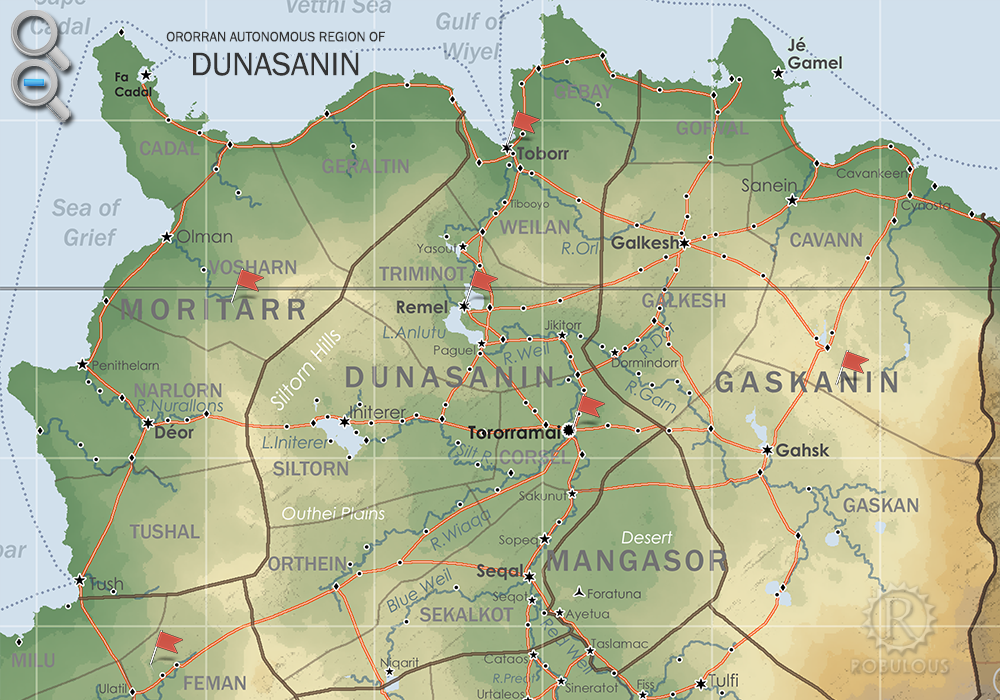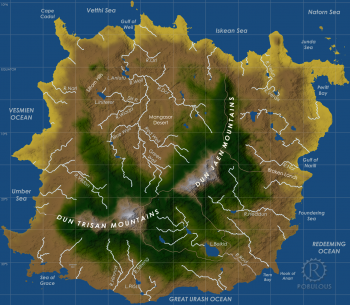Atlas: Mangasor Special Autonomous Region

Mangasor
Mangasor, [mang-GAS-orr, maŋga'sɔ̝ːɾ)] (arch. Mangasuor) also called the Mangasor Desert, is a Special Autonomous Region in central Ororrplugin-autotooltip__small plugin-autotooltip_bigOrorr
Ororr [o-ROARR, ɒ̝rɔ'ɾ], also called the Holy Motherland of Ororr, is a theocratic nation in Anásthias, one of the world's great powers. It the largest nation in the world, perhaps the largest empire in history, occupying the entire northwest of the continent between the mountains and the sea. Ororrlanguagelanguagelanguage. It is a mainly arid region with no permanent surface water, a landscape of rocky plains, dusty dunes and dry lake beds. At the heart of the desert is the holy site of Foratunaplugin-autotooltip__small plugin-autotooltip_bigForatuna
The Sanctuary of Foratuna [Fo-Rah-Too-Nah] is the holiest site of the Mother Church of Ororr: the desert place where the Great Prophet built his sanctuary tower, in which he formulated the principles of the new religion, and laid the foundations for the Ororran state.
The Sanctuary is a complex of religious buildings and housing for the priesthood, including a great hall and holy circle or greenmagicmagic, where the Great Prophet Therionplugin-autotooltip__small plugin-autotooltip_bigGreat Prophet Therion
The Great Prophet Therion (c.30 BME - ?62 ME), often simply called the Great Prophet, was the founder of the Mother Church and nation state of Ororr.
Therism
therism
This is in the series of articles related to the Church of the Mother, commonly called Therism, the state religion of TherionTheristTherion made his home and wrote the key texts of the Therist faithplugin-autotooltip__small plugin-autotooltip_bigMother Church of Ororr (Therism)
The Mother Church is the state religion of Ororr, which combines both religion and government in one institution. It is based on the teachings of the Great Prophet Therion, who in the early decades of the modern era raised an army that conquered much of northwestern OrorrOrorrOrorrOrorrOrorrMEMEOrorrMEMEOrorrOrorrHerHerHerHerHerHerHerHerHerher. It has few settlements other than hill villages, nomad encampments, and outposts of religious hermits.
The desert is peopled by nomadic tribes. It receives little precipitation, but is subject to flooding roughly once a decade, turning a normally dead landscape into a temporary wetland teeming with life.
On its edge is the shrine of Foratunaplugin-autotooltip__small plugin-autotooltip_bigForatuna
The Sanctuary of Foratuna [Fo-Rah-Too-Nah] is the holiest site of the Mother Church of Ororr: the desert place where the Great Prophet built his sanctuary tower, in which he formulated the principles of the new religion, and laid the foundations for the Ororran state.
The Sanctuary is a complex of religious buildings and housing for the priesthood, including a great hall and holy circle or greenmagicmagic, an ancient religious site which is spiritual home to the Mother Churchplugin-autotooltip__small plugin-autotooltip_bigMother Church
The Mother Church of Ororr, also known as Therism., visited by thousands of pilgrims every year.
Geography
Mangasor is a dry endorheic or closed basin, with no surface water flowing in or out. Much of the geology is porous gypsum rock, so that while rainwater does flow from the mountains to the east, almost all of it either evaporates or flows into aquifers deep underground.
The basin is encircled by hills, with the foothills of the Dun Jaen mountains to the east, and the Maresh Hillsplugin-autotooltip__small plugin-autotooltip_bigMaresh Hills
The Maresh Hills are an upland region on the western edge of the Mangasor Basin in central Ororr, most famous for being the site of the holy shrine of Foratuna.
Geologically the hills are a karst escarpment of sedimentary and igneous rock, pocked with caves. Any rainfall immediately sinks through the porous rock, making the hills dry and almost devoid of vegetation other than hardy to the south and west. The lowest point of the basin is a flat dusty lake bed forming a rough figure 8, the entire region roughly 400 km east-west and 700 km north-south.
Temporary Wetland
For most of the time the basin is a desert of skeleton trees and the merest traces of life, since little rain falls on the southwestern slopes of the Dun Jaen. However every decade or so, heavy storms from the east pass over the mountain peaks, swamping hillsides and dislodging accumulated snow and ice. The storm water surges into the Mangasor Basin, turning the desert into a shallow sea, hundreds of kilometres wide. Within days the sea is teeming with life: fish, watersnakes, amphibians, small reptiles, snails, all spawn and lay eggs in a frenzy of life. Grasses grow, swamp-ferns blossom, and the seemingly dried-up sticks and fossilised trunks that litter that desert floor sprout new growth with a canopy of trailing foliage.
This miraculous flowering lasts only six weeks. The waters slowly subside, replaced by grassland overshadowed by flowering bushes, dropping airborne seeds that sink into the rich mud. The fish die, their eggs hatch and the larvae devour their mothers before digging deep into the earth. The vegetation withers as the mud dries, and within a few months the land cracks and slowly turns to dust. The trees drop their branches and return to dormancy. The cracks gradually erode with the wind, and the desert returns for another decade or more.
This miraculous cycle has inspired awe and wonder for millennia. Hermits once lived on rocky outcrops that become islands during the flood. The most famous is a rocky mound covered with dolmens of black pyrite, several hundred miles east of Foratuna. They are almost certainly fragments of an ancient meteorite, which possibly created the basin millions of years ago.
Many of the dolmens have rough human or animal shapes, and myth calls them the mummified corpses of the ancient gods, who died long ago, yet whisper fragments of wisdom to those who wish to hear it. (The Mother Church frowned on and eradicated these legends, and closed the hermitages many centuries ago.)
From desert to lake
The normally desert basin is subject to a miraculous flood once every decade or so, so that the vast dry region becomes a shallow temporary lake for a short time, teeming with life.
Far to the south lie the ice-capped plateaux of the Dun Trisanplugin-autotooltip__small plugin-autotooltip_bigDun Trisan
The Dun Trisan is a range of mountainous uplands in Anásthias, which divide Ororr to the north from the region of Munatan to the south. The Dun Trisan is the southerly extension of the great arc of mountains which divides Anásthias in two, the northerly section being the virid, which feed the mighty River Wiyelplugin-autotooltip__small plugin-autotooltip_bigRiver Wiyel
The River Wiyel or Weil [WILE, WAH-yil] in Ororr is the longest river in the Civilised World. The Wiyel Basin drains two thirds of modern Ororr, running over 5000 km from its source in the southern Dun Trisan mountains, flowing northwards to the sea.
Names
As the river is so long it has been known by many names by different civilisations throughout history. 'Wiel' is the name used during the time of the GreenOrorr, the greatest river in the world. The Dun Jaenplugin-autotooltip__small plugin-autotooltip_bigDun Jaën
The Dun Jaën [doon jay-ENN] is a mountain range in eastern Anásthias, the northern section of the great arc of mountains which, together with the southerly Dun Trisan, separates Ororr from the remainder of the continent.
The Dun Jaen consists of rugged mountains, including the tallest peaks in the mountains to the east are far more precipitous, with mountain valleys blocked by glacial dams of ice and scree. Water and ice gradually build up behind these dams, so that every eleven years or so, the dams burst under the weight, and a mixture of ice, water and rock cascades down the flood-torn valleys beneath the Dun Jaen, causing a catastrophic inundation. As the ice quickly melts, the desert basin becomes flooded with water, turning the barren desert pan into a wetland hundreds of miles wide.
Within days the desert teems with viridplugin-autotooltip__small plugin-autotooltip_bigVirid
Referring to the Virid Kingdom of flora and fauna, toxic to human life. life: lungfish, molluscs, amphibious worms, small reptiles, snails and all manner of plantlife. All these creatures spawn and lay eggs with frenetic energy. Dried sticks blossom into towering swamp-ferns heavy with fluffy seed blooms. Seemingly fossilised tree-trunks explode into a canopy of trailing foliage with fruits of many colours.
This miraculous flowering lasts only six weeks in the fierce desert sun. The waters gradually recede, and the sea becomes a muddy swamp, then a lush grassland, with rich-scented flowering shrubs. The surviving pools are choked with dying fish and voracious predators. As the pools dry out, amphibious creatures lay their eggs in the mud, waiting for a future flood to bring them to life. In some species of worm, once the creature dies their eggs hatch and the larvae devour their mothers before burrowing deep down into the earth, to hibernate til the next flood.
As the land dries out, the vegetation withers and is stripped by migrating herbivores, eventually leaving only dead-looking stumps. The mud dries to a landscape of cracked earth. The cracks gradually erode with the wind, which picks up dust that covers the land. Within half a year the land returns to seemingly barren wilderness, for another decade or more.
The Desert Hermits
This miraculous cycle has inspired awe and wonder for millennia. Hermits once lived in the very centre of the desert, on a series of low hills which become islands during the flood. Each lived alone in a hut roofed with a shallow boat, which they used to travel the waters during the wet season, and in which they were buried when they died. Ancient visitors thought this demonstrated how mad the hermits were, having boats in the desert, although they were essential for harvesting food from the rich bounty the inundation provided.
The most hermitage, Dowaitplugin-autotooltip__small plugin-autotooltip_bigDowait
Dowait [doe-WAIT] is a low mesa in the Mangasor desert, renowned as a site of prehistoric mystic significance.
Ororr
This is in a series of articles on the modern nation-station of Ororr.
Hover to magnify | Go to world map
* Name: Holy Motherland of Ororr * Government:, is several hundred miles east of Foratuna, a hill covered with large stones of iron pyrite, mostly black but streaked with red, greenplugin-autotooltip__small plugin-autotooltip_bigGreen
The Green Kingdom of flora and fauna includes humans, mammals, birds, whales, greenfish, and most green plants and crops cultivated by humankind. and gold. Many are ancient meteorites, fragments from a titanic impact that created the basin millions of years ago. Others are strangely wind-eroded rocks, brought to the mound from elsewhere.
Many of the dolmens have rough human or animal shapes, and myth calls them the mummified corpses of the ancient gods, who died long ago, yet whisper fragments of wisdom to those who wish to hear it.
The hermits told tales of how early Therists, even the Great Prophet himself, once came and stole their greatest god-stones from them, so that ever afterwards the others were silent. The Mother Church frowns on these stories, and closed the hermitages many centuries ago. The site was inhabited for a short time by an enclave of Theristplugin-autotooltip__small plugin-autotooltip_bigMother Church of Ororr (Therism)
The Mother Church is the state religion of Ororr, which combines both religion and government in one institution. It is based on the teachings of the Great Prophet Therion, who in the early decades of the modern era raised an army that conquered much of northwestern OrorrOrorrOrorrOrorrOrorrMEMEOrorrMEMEOrorrOrorrHerHerHerHerHerHerHerHerHerher zealots, but today is remote and abandoned.


